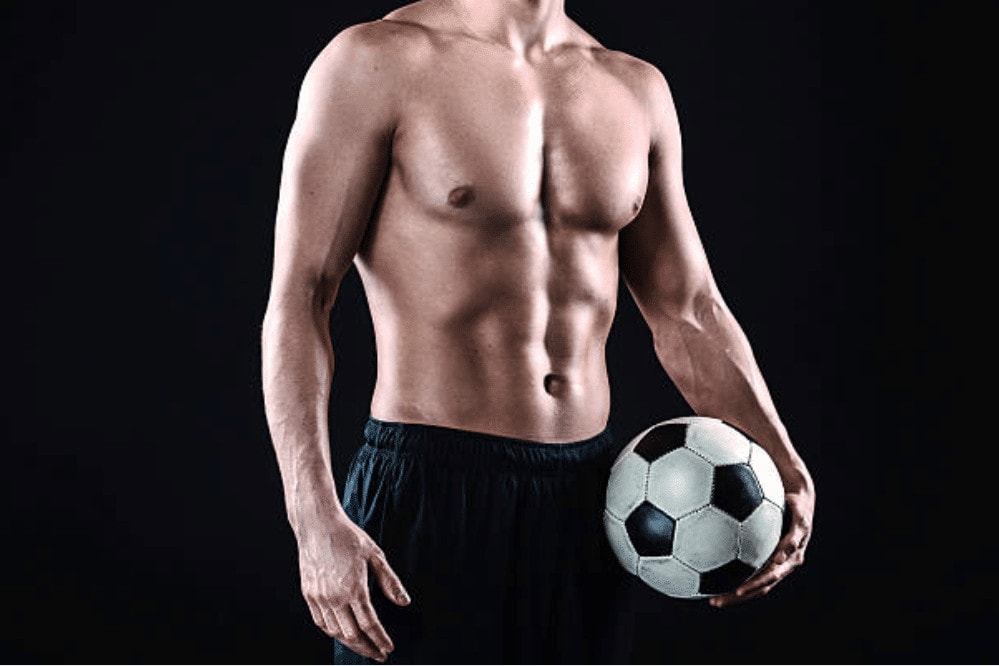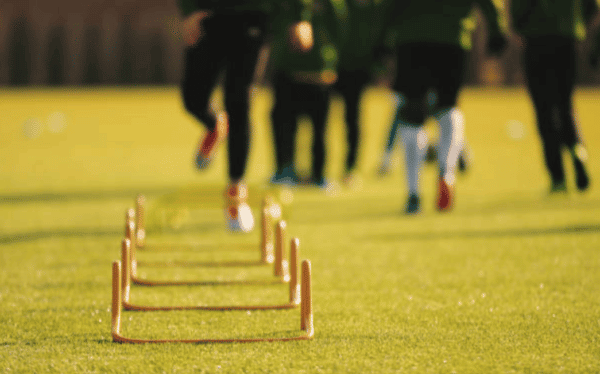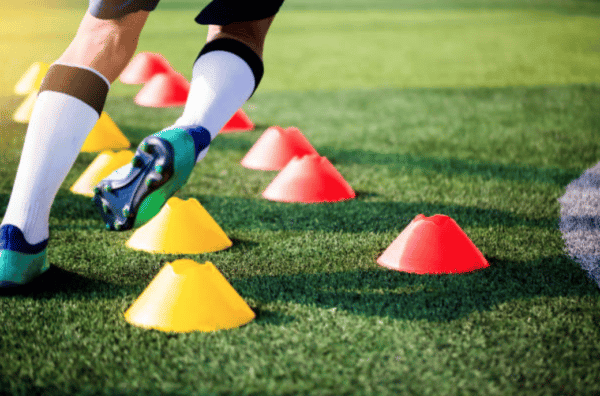Strength training for football
Bodybuilding is the most practiced sport in clubs in France. Often, the practice is only recreational, but if you really want to progress in your game, the technical trainings and the matches will not be enough! Indeed, it is very often advisable to combine several sports to work the whole body, and for football, a weight training program A well thought out and adapted training program can allow you to make enormous progress on the field, both in terms of strength (explosiveness) and endurance. However, it is not a question of building muscle in any way, firstly because you risk injury, but also because football requires the mobilisation of specific muscles and capacities that you must target with precise exercises.
We explain everything in this article!
What is the difference between a bodybuilding program for a bodybuilder and a footballer?
Not everyone has the same objective when it comes to working their muscle groups. Quite simply, the bodybuilder is looking for volume, mass gain and more precisely the muscle gain.
Therefore, they will try to multiply the weight training sessions and will associate them with an adapted diet, with a caloric surplus that allows the gain of weight, then a dryness that allows the elimination of fat and reveals the new musculature.
On the contrary, for the soccer player, it is not about gaining volume (obviously, you can want to gain muscle mass while playing soccer as a second sport, but that is not the subject of this article), but rather about preventing injuries, maintaining and improving your physical condition and fitness.
It is therefore a question of combining the work of cardio-trainingThe coach must therefore prepare "circuit training" that will allow his players to work all their muscle groups. The coach must therefore prepare "circuit training" that will allow his players to work all their muscle groups. It will also be necessary to add stretching sessions, stretching that will help prevent injuries and improve recovery. The footballer therefore seeks a more athletic look than the bodybuilder by focusing on muscle toning.
This preparation in the gym is not reserved for professional athletes, know that it is also a good way for someone who resumes sports to burn calories and sculpt the upper body as well as the bottom.
In short, a strength training program for footballers should focus on muscle and body building, not weight gain, and should be combined with cardio exercises.
What is the training program for a football player in detail?
Which muscles to work on?
In football, the best players are often the fastest, so running speed is an important point to work on. This can be improved with lower body strength training, to improve the player's explosiveness.
It is also a question of working on muscular balance by focusing on the mobility of all the joints, ligaments and rotator muscles, in particular the knees and hips, which are very much in demand during abrupt changes of direction, which can cause joint pain. The muscles absThis means that the shoulder, hip and back must be targeted appropriately.
How to work? What kind of effort?
First of all, it is important to understand that to improve his performance, a footballer must work in anaerobic, that is to say short but intense efforts with short periods of rest interspersed between the periods of effort, this will allow him to develop his endurance.
Indeed, soccer requires intense efforts during the action phases and the time to recover is quite short. Exercises such as jumping rope or jogging with sprints are very effective for working on anaerobic and cardio systems.
The next step is to work on muscular efficiency, i.e. the ability of the muscles to transmit the force generated by the body. Thus, a player can have a lot of strength, but if he does not work on his muscular efficiency, this strength will be useless. For this, it will be necessary to carry out sheathing to develop the rigidity of the body; of the proprioceptionThis includes movements on an unstable support to accustom the body to sudden changes in direction; explosive movements, i.e. movements with weights or plyometrics.
Gaining strength is also necessary to improve his game, but be careful, not a raw strength, it is useless on a soccer field, but rather a strength in the muscles that allows explosiveness, changes of support, precise technical gestures, etc. For this, the player will have to work at between 80 and 100% of his maximum load with exercises to build up the thighs, shoulders, chest and abdominal muscles. They should be fast and light loads.
Finally, after having consolidated his strength, a player must learn to use it quickly, it is what we call the power. To develop it, classic bodybuilding and weightlifting movements at 30% of its maximum load are very effective: Jumping jacks, squat jump, jumping pump, bench press, kettlebell swing, etc. These movements should be performed at a fast pace.
How many sessions per week?
If you really want to progress, two sessions per week will be necessary, each working on a different point (muscular efficiency, strength and power). To these two sessions can be added a session where we will work to prevent injuries stretching, massage, etc.
Are the basics of strength training right for footballers?
As explained above, the movements considered "basic" in bodybuilding, such as squats, lunges, bench presses, etc. are adequate and even recommended for footballers, however, as the aim is to strengthen muscular endurance and not to develop the muscle, it is preferable to favour a large number of repetitions with light loads.
Typical training over a week
Off-season
In order not to lose your physical condition when you do not play regularly, you can add one or two sessions per week, that is to say three or four sessions per week, to each exercise will be made four series of 10 to 12 repetitions, three or four movements will be selected. Think of course about the warm-up before starting your session.
Session 1: Dedicated to the upper body: movements such as bench press, dips, pull-ups or biceps curl
Session 2: Focus on the lower body: Movements such as squats, thigh press, walking lunges, and add some static lifting to strengthen the abdominal belt and lumbar area
Session 3: Reserved for plyometrics, in the form of circuit training: rhythm scale, crossing small hurdles, rapid changes of direction, technical movements with the ball, stair climbing.
In season
You can reduce the number of weight training sessions to save your energy for game days.
Divide your season into several periods: over 8 to 12 weeks you will focus on specific work: Explosiveness / Power / Endurance and speed.
Remember to warm up before starting your session.
Depending on your current goal, the exercises will vary but a typical week will be the same:
Session 1: Dedicated to the upper body, four sets of 8 to 10 repetitions, two or three different movements.
- For explosiveness: Movements such as the deadlift (also for the lower body), bench press, slam push-ups
- For power: Movements such as the inclined bench press, horizontal pull-ups or the dumbbell bench press
- For endurance and speed: Recovery time will decrease as the weeks progress, gradually decreasing from 2:30 to 45 seconds. Movements such as pull-ups, lateral raises or sit-ups with or without load.
Session 2: Dedicated to the lower body, four sets of 8 to 10 repetitions, two or three different exercises.
- For explosiveness: Movements such as walking lunges, box jumps or jumping squats
- For power: Movements such as jumping lunges, thigh presses or Bulgarian squats
- For endurance and speed: Movements such as the thigh press, hip thrust or bodyweight training
To conclude
What you need to remember from this article is that footballers do need to combine their training on the pitch with gym workouts. However, it is not a question of forcing yourself on the weight machines until you hurt yourself, but of choosing your exercises intelligently in order to develop power, rigid and resistant muscles and to tone the body in general.
Need a coach to establish a personalized follow-up that corresponds to your objectives?
Other articles to read :
4 exercises to stretch your calves
Should you continue to exercise over the aches and pains?












2 Comments
another great article of quality
This is very good but we would like to have some sample sessions as an example to understand
Thank you